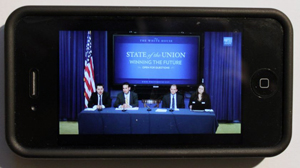 President Obama delivered his second State of the Union address last Tuesday. While the speech was interesting for its political implications, I was drawn to the use of a variety of digital tools and social media services. The White House extended the occasion of a single televised speech with a series of follow-up events aimed at connecting the president and other members of the administration directly with the American people.
President Obama delivered his second State of the Union address last Tuesday. While the speech was interesting for its political implications, I was drawn to the use of a variety of digital tools and social media services. The White House extended the occasion of a single televised speech with a series of follow-up events aimed at connecting the president and other members of the administration directly with the American people.
According to CNN, “such access to top policymakers […] is generally unheard of and reflects the administration’s desire to ensure its messages reach the country, particularly younger Americans who are a core constituency.”
The outreach wasn’t just digital and social but a combination of online and off-line engagement. Many of the online events were held in a room with a live audience. The day after the speech, President Obama went on the road to visit wind and solar energy companies to demonstrate his commitment to clean energy. And the White House team catered to the usual press needs and delivered on other traditional tactics.
It was a whole week of diverse communications activities surrounding and supporting the actual speech. But as part of an integrated communications approach, the team followed its desired youth audience to the online places they are familiar with and use every day. It combined a number of online ideas and internal experts to bring “people a little closer to decisions that get made in Washington” as Press Secretary Robert Gibbs put it.
So what did the White House communications and new media teams do? Here are some of their ideas for content delivery and engagement:
- Online Streaming: In addition to the television broadcast, the speech was streamed live on the White House website and on its Facebook page (where I watched it)
- YouTube Interview: In the days leading up to the speech, Americans were able to use YouTube to submit questions to the President. According to the White House, they received 40,000 questions, and then millions of people voted on which questions should be answered by President Obama. He gave his first interview after the speech by answering these questions in a video that was posted to YouTube and the White House website
- Social Panel: Immediately after the speech, a panel of senior white house directors was ready to answer questions posed by Americans live via Twitter, Facebook and a form on the White House website; I watched part of that session over the official White House mobile application for the iPhone, which includes a news feed and a live video function; it also available on YouTube
- Twitter Q&A: On Wednesday, White House communications director Dan Pfeiffer answered questions in a live Twitter session
- Conference Call: On Wednesday evening, senior White House staff planned to hold a conference call to discuss “issues that matter most to young Americans”; young people interested in participating were able to RSVP through a web form
- Policy Discussion via Facebook: On Thursday, live roundtables were held by “policy experts” where people could submit questions in advance or live on Facebook while it was broadcast online
- Blog Exclusive: Americans were encouraged to pose questions for vice president Biden through a Yahoo.com politics blog, which he then answered in video interviews with a Yahoo staff reporter
- Behind the Scenes Video: A number of Americans were selected to sit with the First Lady in her viewing box during the State of the Union speech. Guests were shown in a behind the scenes video and an interactive feature
- Embracing Reactions: On its blog, the White House selected and published reactions to President Obama’s speech
- Word Cloud: The blog team posted a word cloud for the State of the Union Speech created by social media service Wordle
Was it successful? Other than the numbers provided as part of the presidential YouTube interview, I have not seen any stats. The increasing digital and social media integration seems to reflect the American government’s desire to find more ways of communicating directly to citizens while decreasing the reliance on traditional interpretive filters of journalists and pundits.
As much as it is true that social media success is fueled by the willingness of organizations to embrace a certain lack of control, online activities around the State of the Union address were held based on the terms set by the White House communications team. They responded to critical voices but were selective in their engagement.
Social media usage in the public sector will continue to grow as more government organizations are gaining experience in sharing information and listening to citizens through the use of digital technology. As exciting as it is too see what’s possible today, it is important to keep in mind that behind the public layer of social media engagement, there needs to be change to the internal “state of mind,” so that social media is embedded into the organization, and not simply an add-on. Getting there is a step by step process with a considerable investment in time and resources, including people and platforms, so that the organization can develop the confidence required to embrace change.
The White House already has years of experience in social media implementation and integration. The execution of the State of the Union address was just the latest visible iteration of this evolution.
